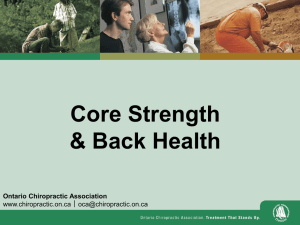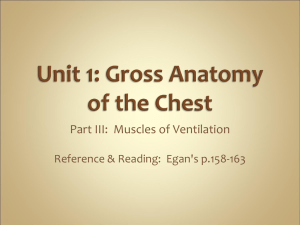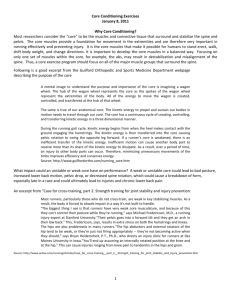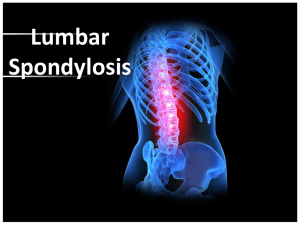Local Stabilization Muscles
advertisement
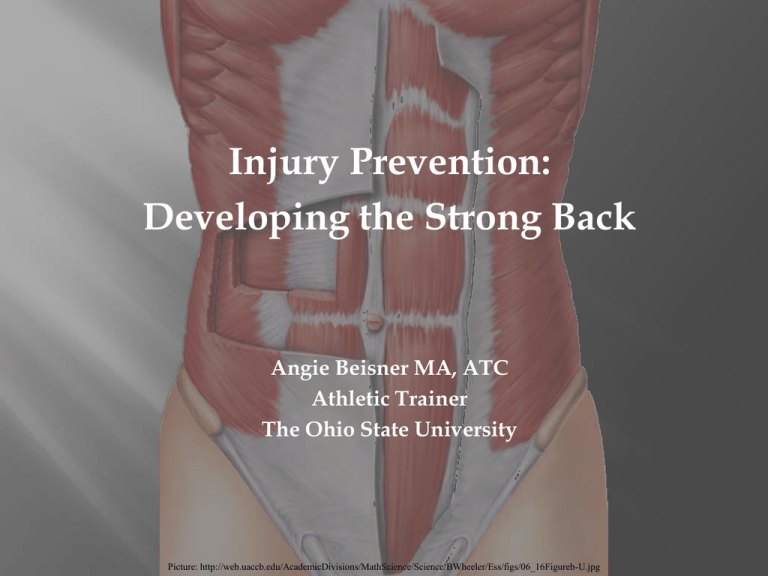
Injury Prevention: Developing the Strong Back Angie Beisner MA, ATC Athletic Trainer The Ohio State University Picture: http://web.uaccb.edu/AcademicDivisions/MathScience/Science/BWheeler/Ess/figs/06_16Figureb-U.jpg • Incidence • Sport Specific • Types of Injuries Flexibility Core Stabilization Exercises Postural Training • Local Muscle Stabilization programs • Pilates, Yoga programs • Functional Movement Screenings Global Abdominal Muscles Local Abdominal Muscles • Rectus Abdominis • External Oblique Rectus Abdominis • Iliocostalis (thoracic portion) http://home1.gte.net/imagine/rectus%20abdominis.jpg External Oblique http://www.mystomachexercises.com/wpcontent/uploads/2008/04/external-oblique.jpg Iliocostalis (thoracic portion) http://www.pro-motionphysicaltherapy.com/images/evidence/5il.jpg • Large Muscles • Act on the Spine (no attachment) • Provide Trunk Stabilization (no influence on the spine) • Global Stabilization Muscles include: Rectus Abdominis External Oblique Iliocostalis (thoracic portion) • Lumbar Multifidus • Transverse Abdominis • Post. Fibers of Int. Obliques Posterior fibers of Internal Obliques http://www.teachpe.com/images/muscles/internal_oblique200.jpg https/://hvelink.saintlukeshealthsystem.org/library/healthguide/en-us/images/media/medical/hw/h9991417_001.jpg • Direct attachment to lumbar vertebrae • Control lumbar segments • Dynamic stability of the spine • Intra-abdominal pressure • Local Stabilization Muscles include: Lumbar Multifidus Transverse Abdominis Posterior Fibers of Internal Oblique • Global Muscles: Typical focus of back rehab Substitute/Dominate local muscles in people with CLBP Local Muscles provide: • dynamic stability • control of the spine Increased evidence showing LBP is influenced by local muscle weakness Lumbar spine problems Studies have shown specific exercises directed at local muscles are effective in reducing pain • This is due to the dysfunction in parts of lumbar spine in people with chronic/symptomatic back problems (i.e. spondys) Training Local Stabilization Muscles May compensate for forces on the spine during ADL Leads to increased stability=decreased pain/disability http://www.lower-back-pain-answers.com/images/Pelvic-tilt-arching-elbows.jpg Train for a contraction of deep abdominal muscles/LM • • • Must be specific Minimal activation of global muscles Patient must be compliant Goal: • Teach contraction of LM and TrA independent of Global Muscle Firing TrA • • 2 fingers medial and distal to ASIS Slowly draw in abdominal wall LM • • Fingers side of spinous process “Make fingers expand” Sides may have unequal firing May be unable to maintain for 10s May need to incorporate tactile stimulation May have weak contraction • Once achieved, add to standing/dynamic tasks • Add Global exercises (core program) to rehab • Perform exercise throughout the day • Continued compliance is needed to reinforce motor programming 1999-2000 • • 2000-2001 • 0 back injuries 2003-2004 • 2 spondylosis 1 lamina fracture 2002-2003 • 1 spondylosis 2001-2002 • • 1 spondylolisthesis 1 spondylosis 1 spondylosis (freshman) 2004-2007 Increase number of athletes using jump serve New athletes No changes in: • • • • Floor Lifting program Practice Equipment Random check of previous athlete with LBP • • Symptomatic Asymptomatic Given instructions to begin exercise • Once achieved mastery, must incorporate into ADL • Two things were implemented as prevention techniques with this team: • • • Local muscle screening Addition of Pilates focused exercises While a formal study was not initiated, results were noticed. Potential Benefits: • Focus is on “local” muscle group such as transverse abdominis, multifidus, and pelvic floor muscles • Emphasizes proper technique • Aid for postural control Pilates intervention has shown: • Pain relief and improved weight distribution in those with LBP daFonseca J, Magini M, and de Freitas T. Laboratory gait analysis in patients with low back pain before and after a pilates intervention. Journal of Sport Rehabilitation. 2009; 18:269-282 • Increase Transverse Abdominis firing Endleman I, and Critchley D. Transverse Abdominis and Obliqus Internus Activity during pilates exercises: measurement with ultrasound scanning. Arch Phy Med Rehabilitation 2008; 89:2205-2212. Proper technique • Muscle thickness (firing) is only increased if performed correctly Reformer based exercises vs. mat based • Exercises used were mat 100s, leg circles Endleman I, and Critchley D. Transverse Abdominis and Obliqus Internus Activity during pilates exercises: measurement with ultrasound scanning. Arch Phy Med Rehabilitation. 2008; 89:2205-2212 New area of injury prevention focus Limited research to show effectiveness with low back pain prevention • Some research support effective tool for LBP prevention in certain rigorous occupations (i.e. fire fighters) Theory: • Program focus on flexibility, muscle balance may have a link to decrease LBP First step of rehab Make it a challenge Random checks Awareness Missing Link in low back rehab programs Extra step to break the cycle of CLBP daFonseca J, Magini M, and de Freitas T. Laboratory gait analysis in patients with low back pain before and after a pilates intervention. Journal of Sport Rehabilitation. 2009; 18:269-282 Endleman I, and Critchley D. Transverse Abdominis and Obliqus Internus Activity during pilates exercises: measurement with ultrasound scanning. Arch Phy Med Rehabilitation. 2008; 89:2205-2212 Gladwell V, Head S, Hagger M, and Beneke R. Does a Program of Pilates Improve Chronic Non-Specific Low Back Pain. Journal of Sports Rehabilitation. 2006; 15:338-350 McCook D, Vicenzino B, and Hodges P, Activity of deep abdominal muscles increases during submaximal flexion and extension efforts but antagonist co-contraction remains unchanged. Journal of Electromyography and Kinesiology. 2009; 19:754762 Wallwork T, Stanton W, Freke M, and Hides J. The effects of chronic low back pain on size and contraction of the lumbar multifidus muscle. Manual Therapy. 2009; 14:496-500 Hall L, Tsao H, MacDonald D, Coppieters M, and Hodges P. Immediate Effects of co-contraction training on motor control of the trunk muscles in people with recurrent low back pain. Journal of Electromyography and Kinesiology. 2009; 19:763-773 Peate W, Bates G, Lunda K, Francis S, and Bellamy K. Core Strength: A new model for injury prevention and prediction. Journal of Occupational Medicine and Toxicology. 2007; 2:3 1-9 Hicks G, Fritz J, Delitto A, and McGill S. Preliminary Development of a Clinical Prediction Rule for Determining Which patients with low back pain will respond to a stabilization exercise program. Arch Phy Med Rehabilitation. 2005; 86:1753-1761 Sapsford R, Hodges P, Richardson C, Cooper D, Markwell S, and Jull G. Co-activation of the abdominal and pelvic floor muscles during voluntary exercises. Neurology and Urodynamics. 2001; 20:31-42 O’Sullivan P, Phyty G, Twomey L, and Allison G. Evaluation of Specific Stabilizing Exercises in the Treatment of chronic low back pain with radiologic diagnosis of spondylolysis and spondylolisthesis. Spine. 1997; 24:2959-2967 Hodges P. Changes in motor planning of feed forward postural responses of the trunk muscles in low back pain. Exp Brain Research. 2001; 141:261-266 Hodges P, Cressswell, A and Thorstenson A. Preparatory trunk motion accompanies rapid upper limb movement. Exp Brain Research. 1999; 124: 69-79 Hides J, Scott Q, Jull G, and Richardson C. A clinical palpation test to check the activation of the deep stabilizing muscles of the lumbar spine. International SportsMed Journal. 2000; 1:4 Hides J, Jull G, and Richardson C. Long term effects of specific stabilizing exercises for first episode low back pain. Spine. 2001; 11:E243-E248

